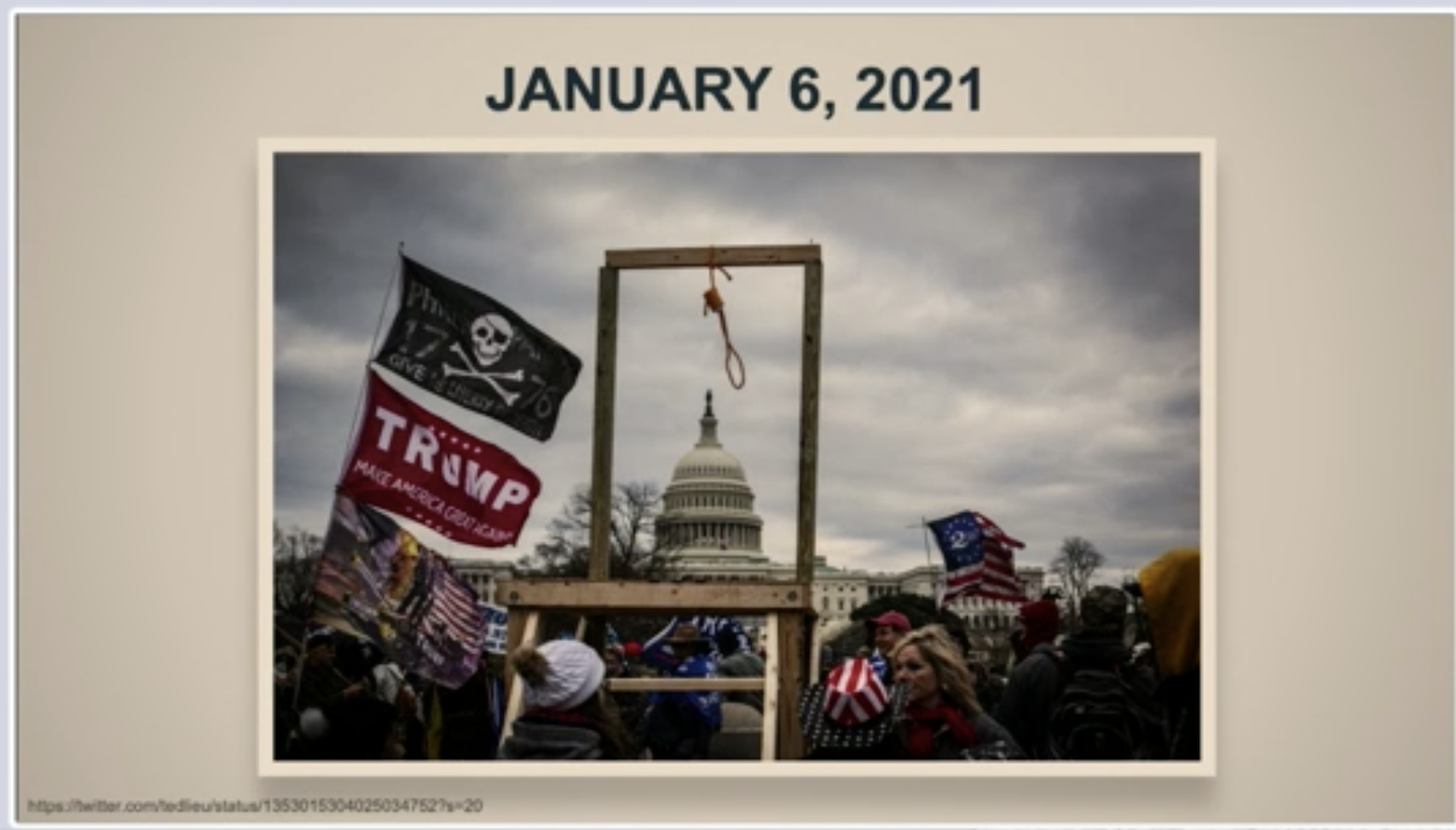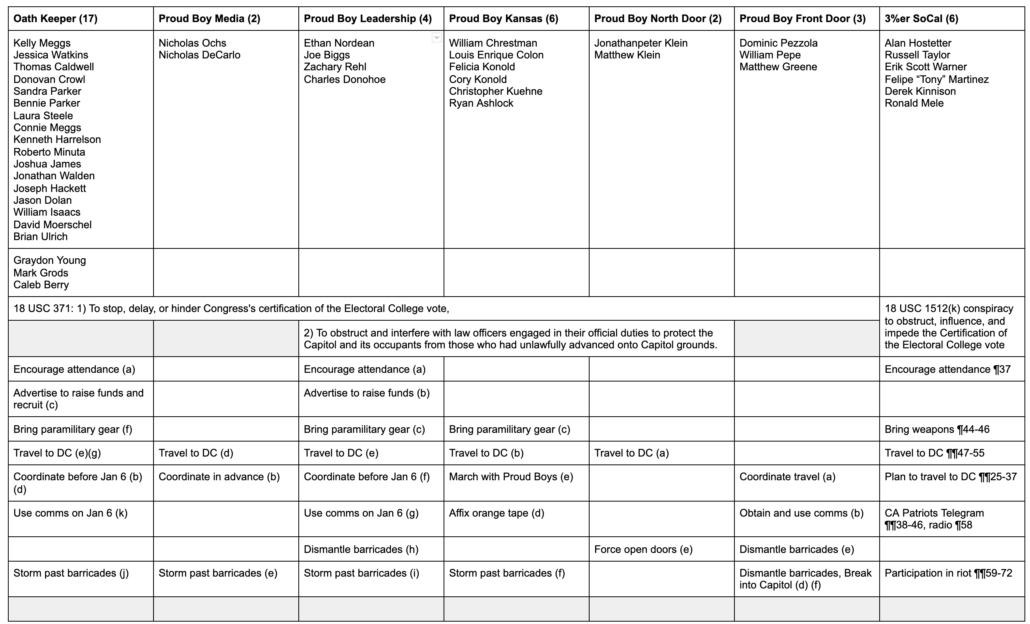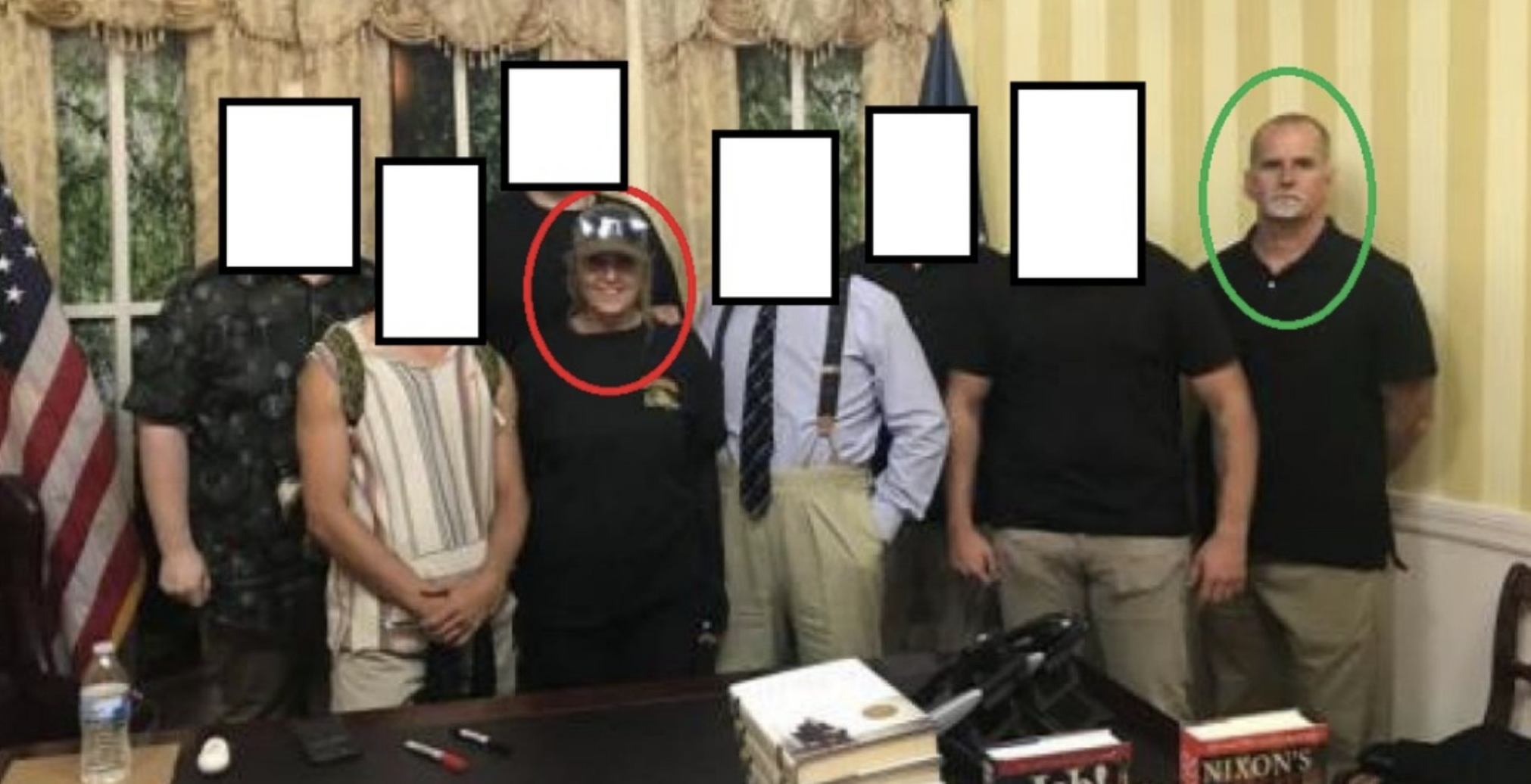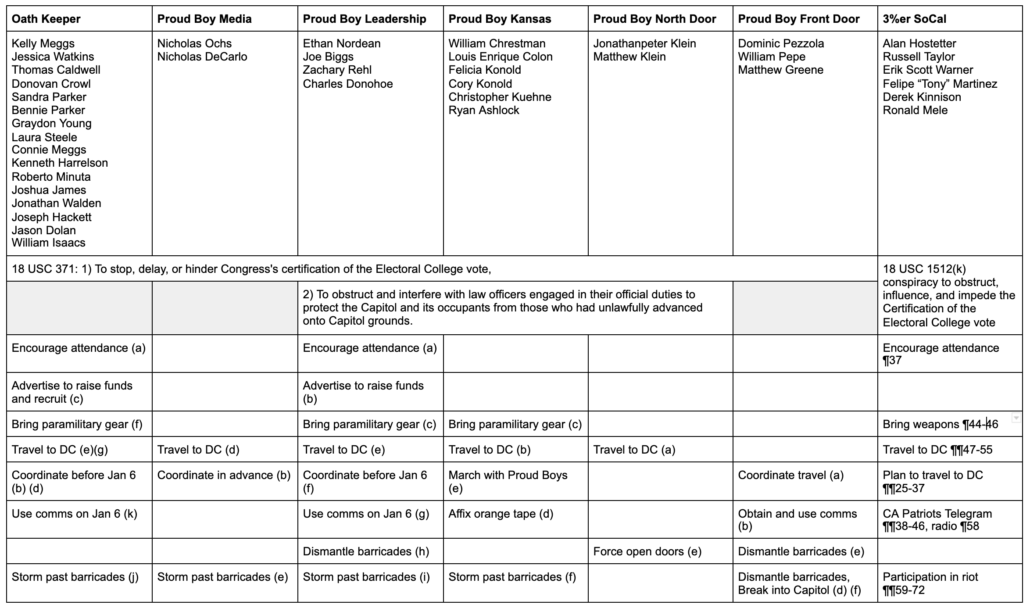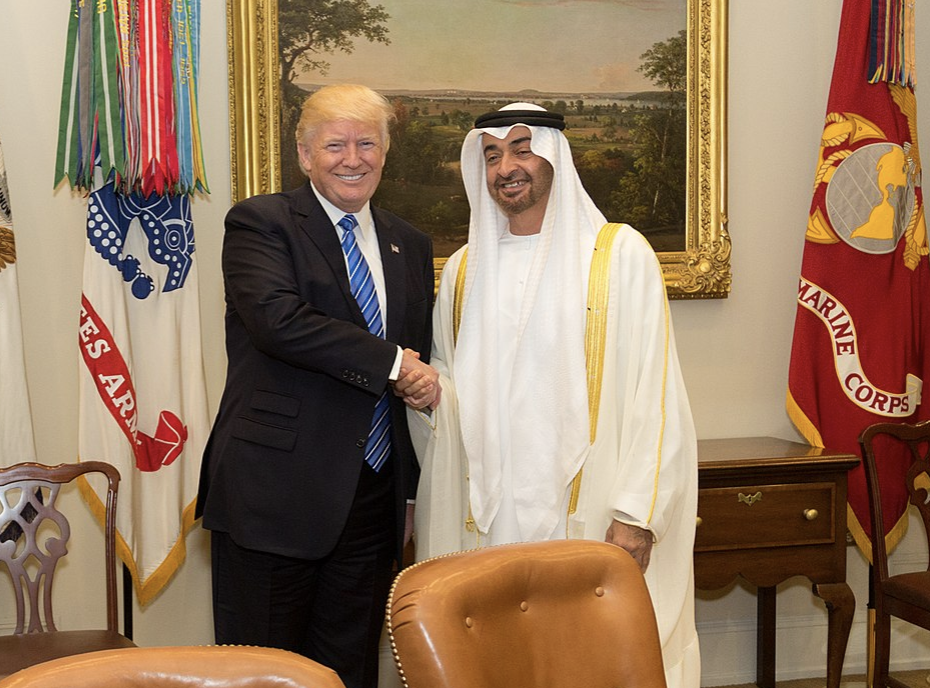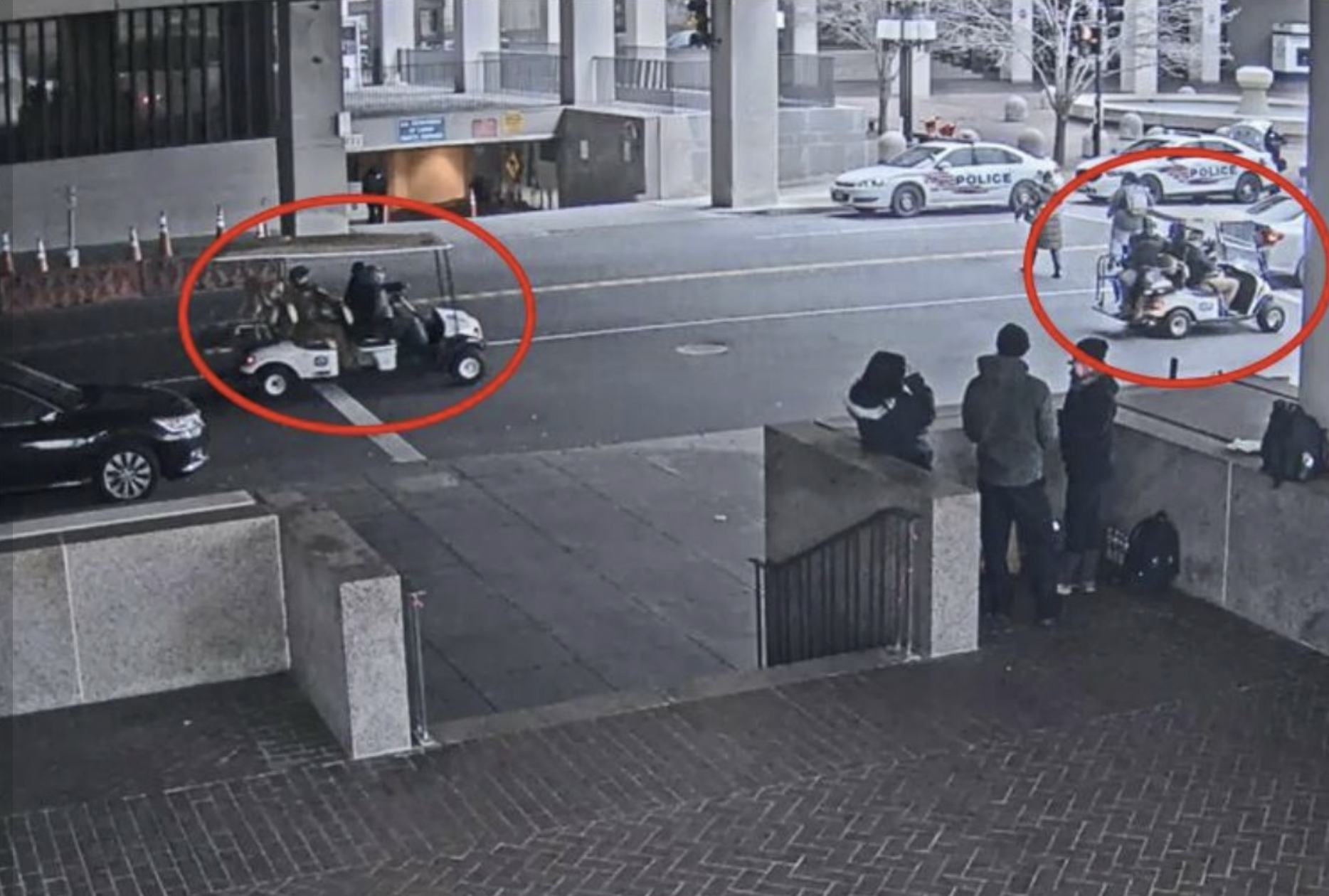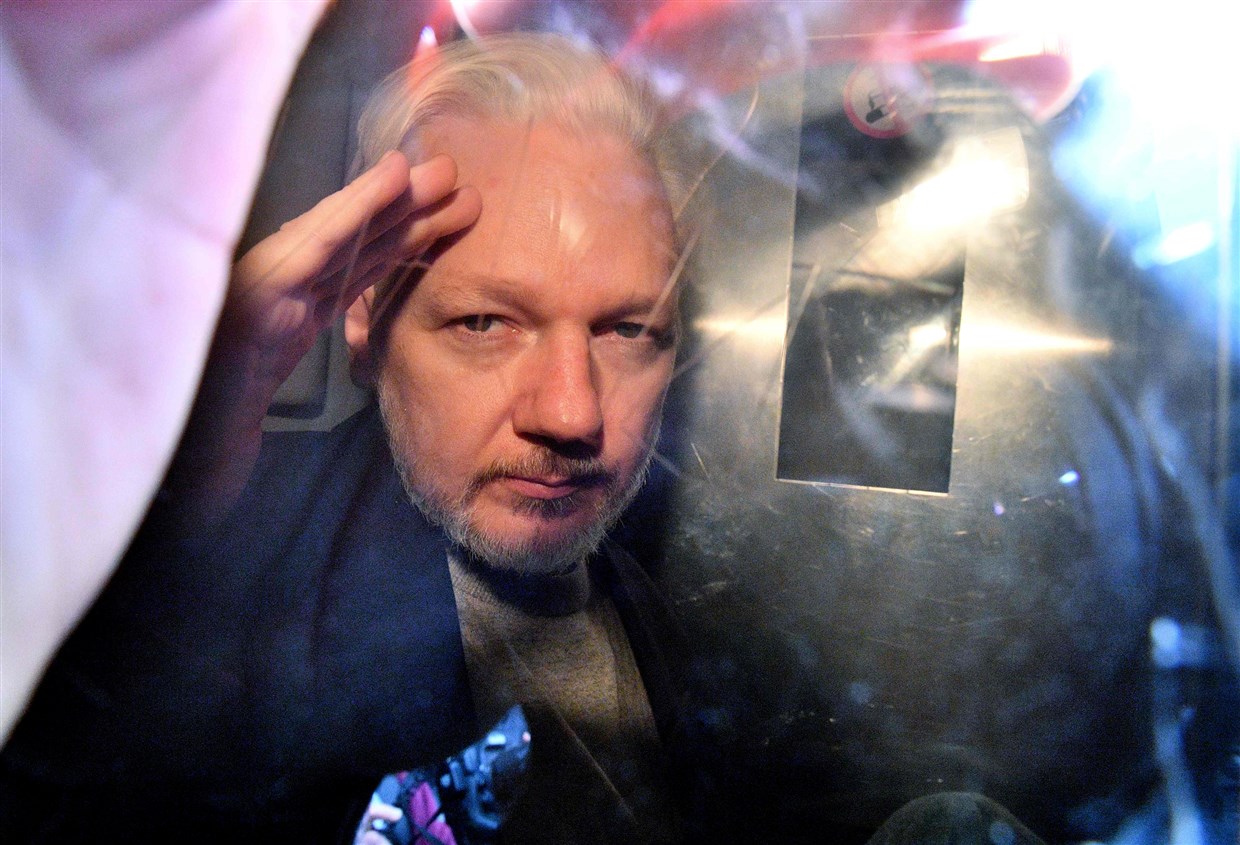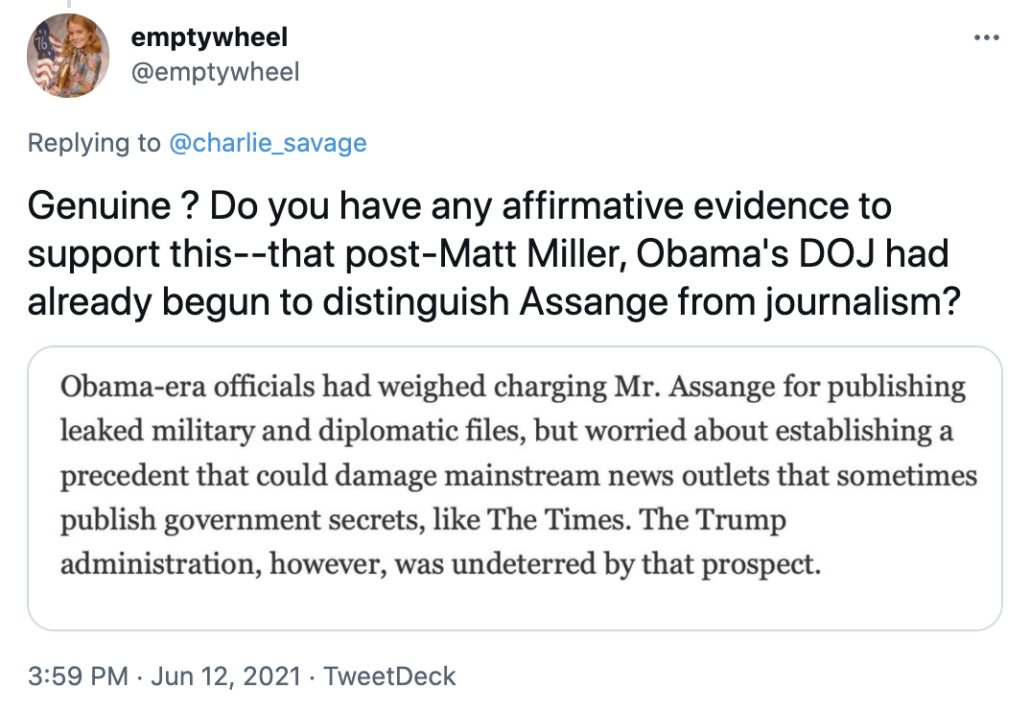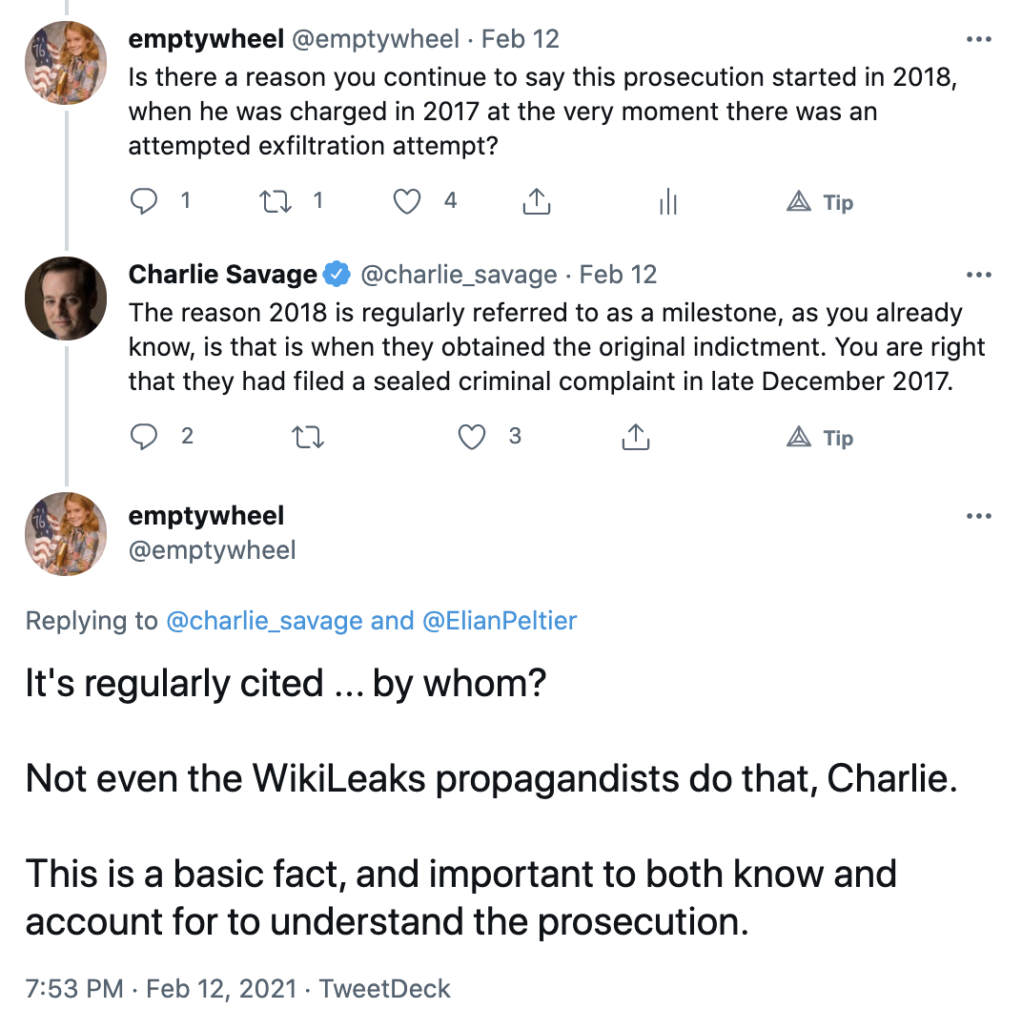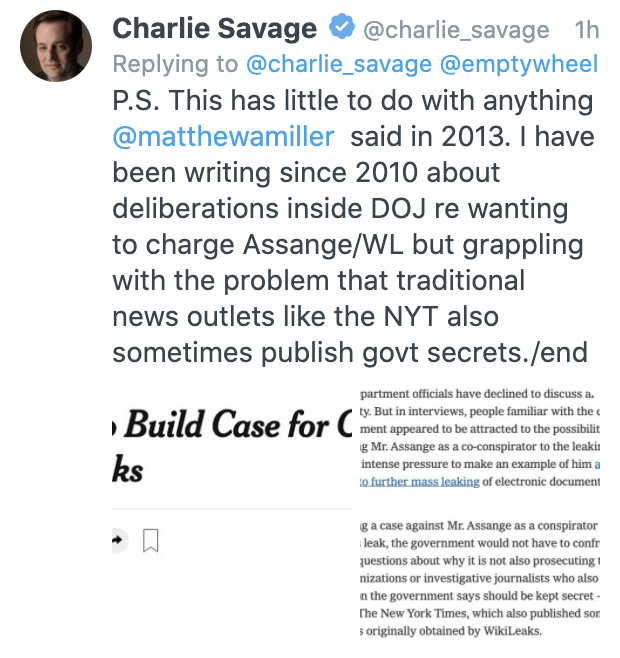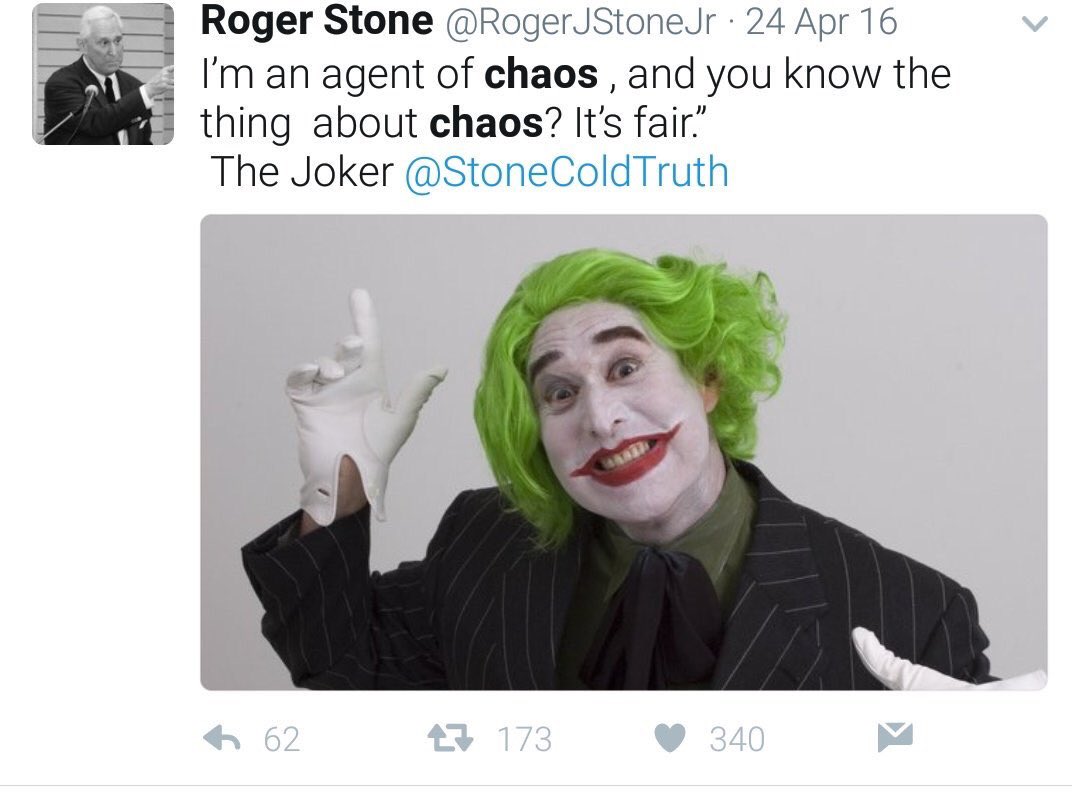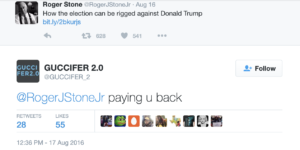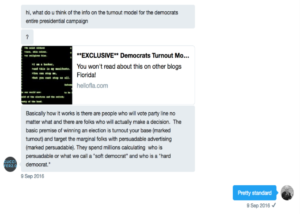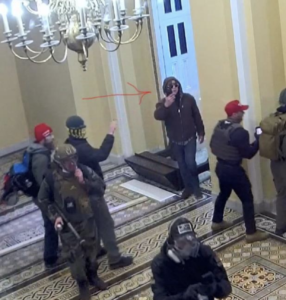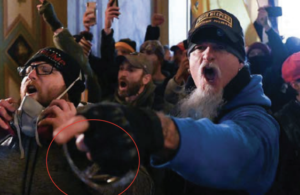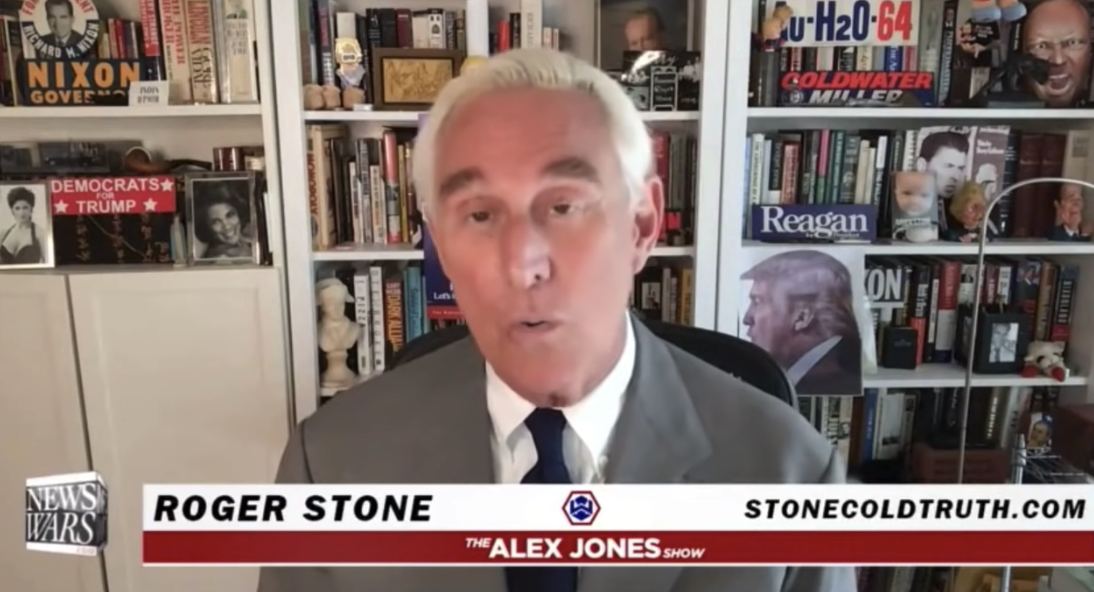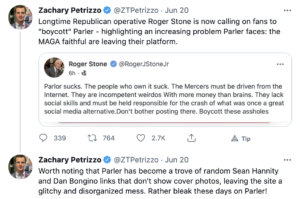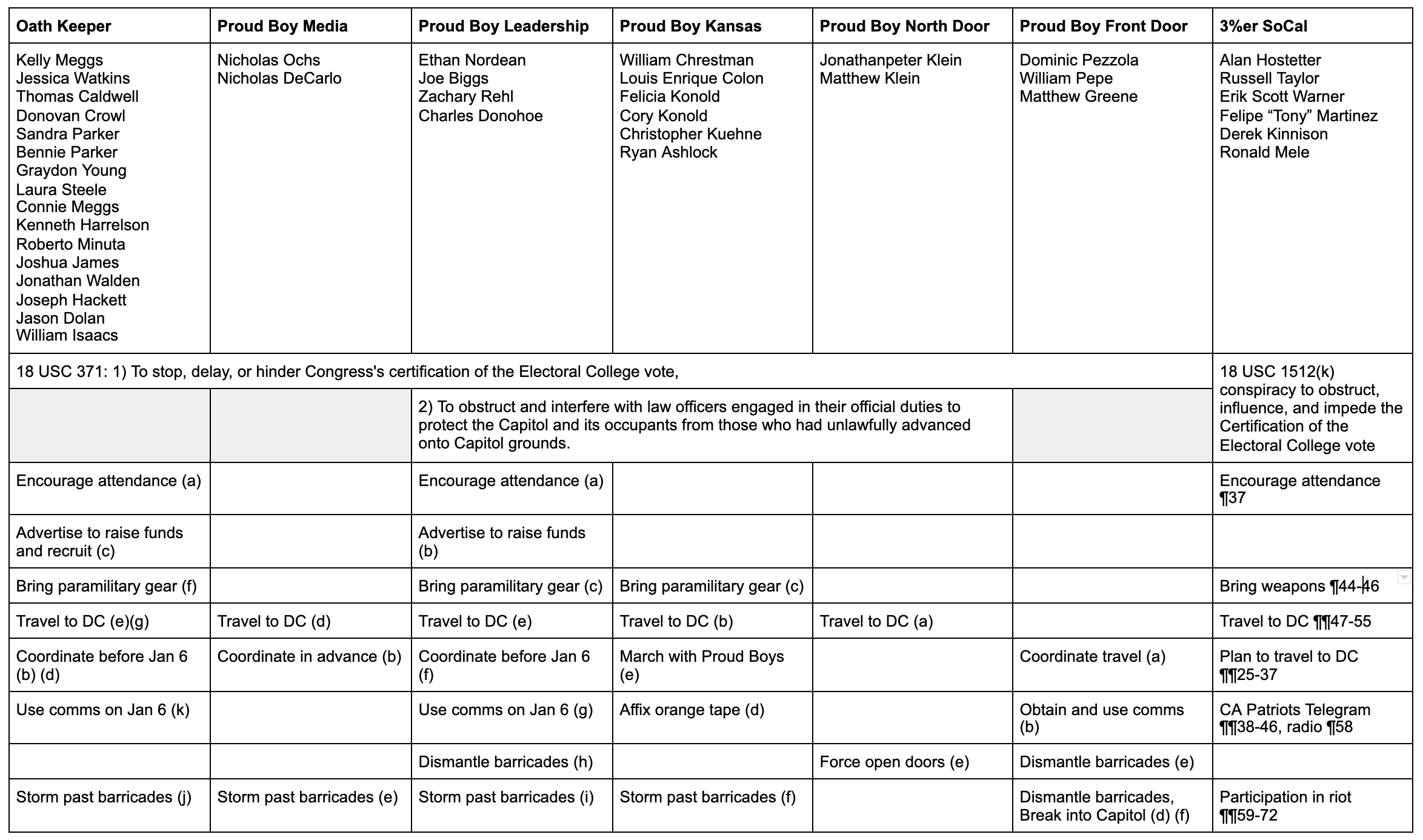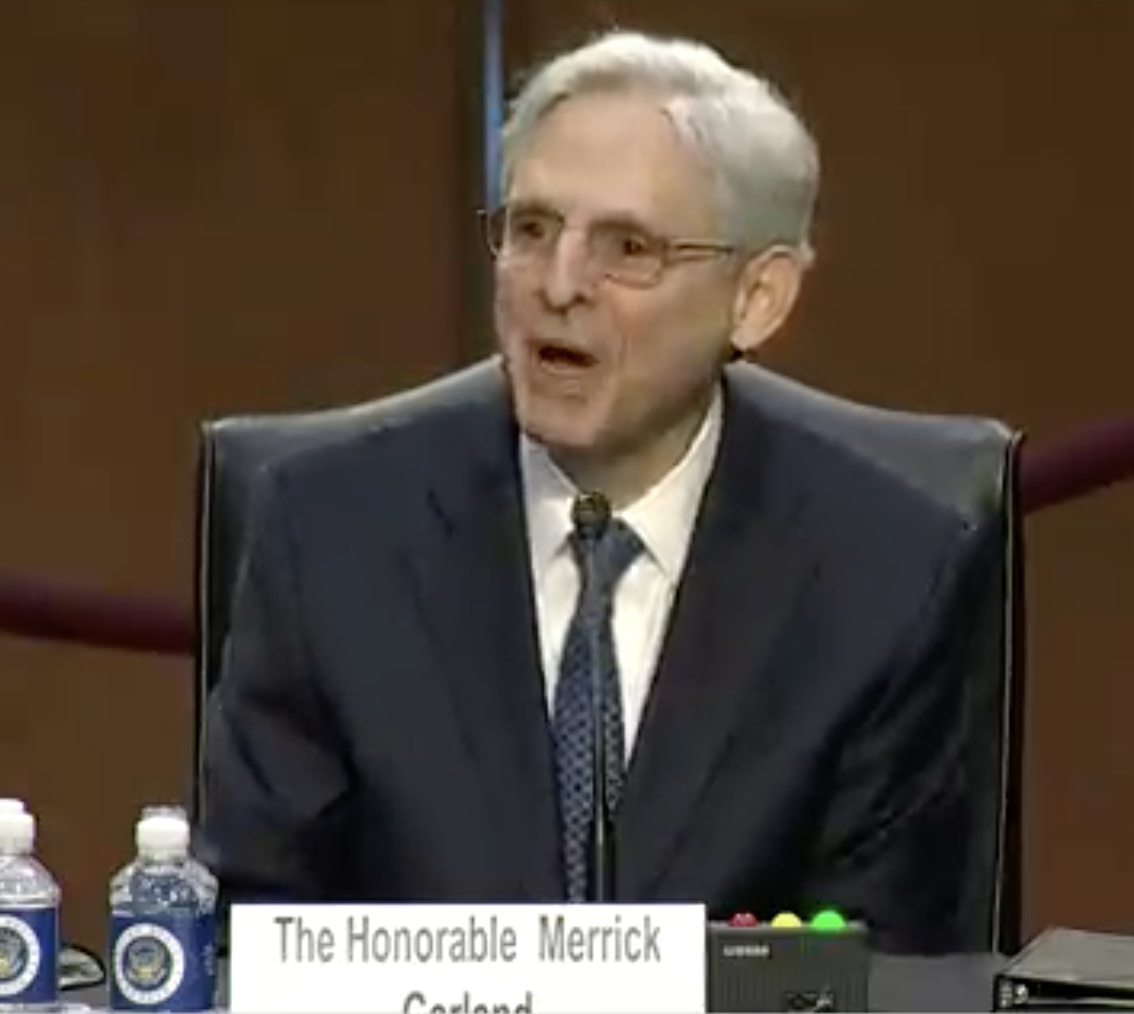How a Trump Prosecution for January 6 Would Work
Jeffrey Toobin wrote a shitty piece arguing — seemingly based exclusively on Trump’s request to Jeffrey Rosen to delegitimize the election results in Georgia and Trump’s January 6 speech — that Merrick Garland should not prosecute Trump.
Toobin’s piece sucks for the same reason that all the mirror image articles written by TV lawyers, the ones explaining how DOJ might prosecute Trump, also suck: because none exhibit the least familiarity with how DOJ is approaching January 6, much less what allegations it has already made in charging documents. They are, effectively, nothing more than throwing a bunch of laws at the wall to see whether any stick (and in Toobin’s estimation, none do).
Almost none of these TV lawyers engage with how DOJ is applying obstruction as the cornerstone of its January 6 prosecutions. For example, Toobin considers whether Trump obstructed justice, but he only analyzes whether, when, “Trump encouraged the crowd to march to Capitol Hill but he did not explicitly encourage violence,” Trump obstructed the vote certification. Of around 200 January 6 defendants charged with obstruction, I can think of few if any against whom obstruction has been charged based solely on their actions on the day of the riot, and Trump is not going to be the exception to that rule. As with other January 6 defendants, DOJ would rely on Trump’s words and actions leading up to the event to prove his intent.
In this post, I want to lay out how a DOJ prosecution of Trump for January 6 would work. I’m not doing this because I’m sure DOJ will prosecute. I’m doing it to make the commentary on the question less insufferably stupid than it currently is.
Assumptions
The piece makes three assumptions.
First, it assumes that DOJ’s current application of 18 USC 1512(c)(2) to cover the vote certification survives judicial review. It’s not at all clear it will, either because the courts (this will go to SCOTUS) don’t believe Congress intended to include Constitutionally-mandated official proceedings like the vote certification in a law covering official proceedings, because the courts will decide that rioters had no way of knowing that interrupting Constitutionally-mandated official proceedings was illegal, or because courts will decide that rioters (all of them, as opposed to one or another making a compelling case to a jury) did not have the requisite corrupt purpose. There are currently at least nine challenges to the application of the law (at least two more have been raised since Judge Randolph Moss had prosecutors put together this list). If TV lawyers want to argue about something, this might be a more productive use of their time than arguing about whether Trump can be prosecuted more generally, because the question doesn’t require knowing many actual facts from the investigation.
This piece also assumes that DOJ would apply two things they asserted in a filing pertaining to Mo Brooks to Trump as well. That filing said that the scope of federal office holder’s job excludes campaign activity, so any campaign activity a federal office holder engages in does not count as part of that person’s duties.
Like other elected officials, Members run for reelection themselves and routinely campaign for other political candidates. But they do so in their private, rather than official, capacities.
This understanding that the scope of federal office excludes campaign activity is broadly reflected in numerous authorities. This Court, for example, emphasized “the basic principle that government funds should not be spent to help incumbents gain reelection” in holding that House or Senate mailings aimed at that purpose are “unofficial communication[s].” Common Cause v. Bolger, 574 F. Supp. 672, 683 (D.D.C. 1982) (upholding statute that provided franking privileges for official communications but not unofficial communications).
DOJ also said that conspiring to attack your employer would not be included in a federal office holder’s scope of employment.
Second, the Complaint alleges that Brooks engaged in a conspiracy and incited the attack on the Capitol on January 6. That alleged conduct plainly would not qualify as within the scope of employment for an officer or employee of the United States, because attacking one’s employer is different in kind from any authorized conduct and not “actuated . . . by a purpose to serve” the employer. Id. § 228(1)(c).
These two principles, taken together, would get beyond some of the challenges involved in investigating someone covered by Executive Privilege and making orders as Commander-in-Chief. Importantly, it would make Trump’s activities in conjunction with the January 6 rally subject to investigation, whereas they broadly wouldn’t be if they were done in Trump’s official capacity.
Finally, if DOJ were to charge Trump, they would charge him in a conspiracy to obstruct the vote count that intersected with some of the other conspiracies to obstruct the vote count, possibly with obstruction charges against him personally. In general, I don’t think DOJ would charge most of Trump’s discrete acts, at least those conducted before January 20, as a crime. There are two possible exceptions, however. His call to Brad Raffensperger, particularly in the context of all his other efforts to tamper in the Georgia election, would have been conducted as part of campaigning (and therefore would not have been conducted as President). It seems a clearcut case of using threats to get a desired electoral outcome. It’s unclear whether Trump’s request that Mike Pence to commit the unconstitutional action — that is, refusing to certify the winning electoral votes — would be treated as Presidential or electoral. But that demand, followed closely with Trump’s public statements that had the effect of making Pence a target for assassination threats, seems like it could be charged on its own. Both of those actions, however, could and would, in the way DOJ is approaching this, also be overt acts in the conspiracy charged against Trump.
The other conspiracies
If DOJ would only charge Trump in the context of a conspiracy to obstruct the vote (with whatever other charges added in) that intersects with some or all of the other conspiracies charged, it helps to understand what DOJ has done with those other conspiracies. Here’s what the currently charged conspiracies look like:
DOJ has been treating the multiple Proud Boy conspiracies as one (about which Ethan Nordean is complaining); I think they’re doing that — and excluding other key players who could be in one of the conspiracies, including all the most serious assaults committed by Proud Boy members — as a way to show how the cell structure used on the day worked together to serve a unified purpose, while also managing visibility on different parts of their ongoing investigation. For my purposes here, I’ll focus on the Leadership conspiracy, with the understanding that (notwithstanding Nordean’s complaints) DOJ credibly treats the others as the implementation of the conspiracy the Proud Boy Leaders themselves have laid out.
All of these conspiracies, as well as a disorganized militia conspiracy DOJ has been saying they’ll charge, share the same object: to stop, delay, or hinder Congress’ certification of the Electoral College win. Basically, all these conspiracies, as well as a hypothetical one that DOJ might use against Trump, would involve ensuring that he still had a route to remain in power, that he lived to fight another day. By themselves they did not involve a plan to remain in power (though Trump could be charged in a broader conspiracy attempting to do that, too).
They also all allege common Manners and Means (to be clear, these defendants are all presumed innocent and I’m speaking here of what DOJ claims it will prove). Those include:
- Agreeing to plan and participate in an effort to obstruct the vote certification
- Encouraging as many people as possible, including outside their own groups, to attend the operation
- Funding the operation
- Preparing to make participants in the operation as effective as possible, in all cases including communication methods and in most cases including some kind of defensive or offensive protections
- Illegally entering the Capitol or its grounds and occupying that space during the period when Congress would otherwise have been certifying the vote
While all of those conspiracies follow the same model, there are some unique characteristics in four that deserve further mention:
Proud Boy Leaders Conspiracy: Operationally, those charged in the Proud Boy Leaders conspiracy managed to assemble a mob, including Proud Boy members (many organized in sub-cells like the Kansas City cell Billy Chrestman led), fellow travelers who met up and marched with the Proud Boys that morning, and those who knew to show up at 1PM (while Trump was still speaking). With apparent guidance from the charged co-conspirators, the Proud Boys managed to kick off the riot and — in the form of the Proud Boy Front Door co-conspirator Dominic Pezzola wielding a stolen shield — break into the building. Thus far (probably in part because Enrique Tarrio is not currently charged in this or any conspiracy), the government has been coy about what evidence it has of coordination with others, including at a December MAGA March in DC. Key planning steps, however, involve deciding not to show Proud Boy colors the day of the riot and fundraising to buy gear and support travel (Christopher Worrell got to DC on a bus paid for by the Proud Boys but that has not yet been charged in any conspiracy). On top of radios and blow horns, two Telegram channels — the larger of which had 60 members — appear to have played key roles in organizing events the day of the riot. To the extent that Proud Boys came armed, they appear to have done so individually, and thus far, DOJ has not included the worst assaults committed by Proud Boys in any of the conspiracies. Several of the charged co-conspirators started talking about war in the days and weeks after the election and those who gathered with the Proud Boys on the morning of the riot skipped Trump’s rally, making their focus on the vote certification much clearer than many others that day.
Oath Keeper Conspiracy: The indictment alleges this conspiracy started on November 9 with a plan both to use Antifa as a foil to excuse violence and in expectation that that violence would be Trump’s excuse to invoke the Insurrection Act and/or respond to that call. The conspiracy used the promise of serving as security — both at the rally and for Roger Stone and other “dignitaries” — to recruit people to come to DC, and in fact a number of the charged co-conspirators were present with Stone the morning of the riot. In addition to kitting out in various Oath Keeper gear at different events on the day of the event, the militia had a serious stash of weapons at the Ballston Comfort Inn in case things did turn violent. The key thing, operationally, this conspiracy achieved was to provide organized brawn to an effort to open a second front to the attack via the East Door of the Capitol. The nominal head of this conspiracy, Florida State head Kelly Meggs, claimed to have set up an alliance with other militias in Florida (he first made the claim a day after the militia had provided “security” for Stone at an event in Florida). Over the course of the investigation, the government has also gotten closer to alleging that Meggs expressed the desire to and took steps to target Nancy Pelosi personally while inside the Capitol.
3%er Southern California Conspiracy: The men charged in this conspiracy — who occupy the overlap between 3%ers and the anti-mask community in Southern California — organized themselves and others to come armed to the Capitol. As alleged, they started organizing formally in explicit response to Trump’s December 19 advertisement for the event. Both online and in an appearance by Russell Taylor at the rally on January 5, they called for violence. They organized in advance via Telegram chat and on the day with radios. Operationally, these men personally participated in the fighting on the west side of the Capitol (most never went in the building but the government contends they were in restricted space outside). But from a larger standpoint, these men form one intersection between the more formal Trump organization behind the rallies and a group of radicalized Trump supporters from across the country.
Disorganized Conspiracy: You’ve likely never heard of Ronnie Sandlin and Nate DeGrave, nor should you have. Their conspiracy (DOJ has not yet charged it but has been planning to do so since April) started when Sandlin responded to Trump’s calls for people to attend the event on December 23 and started looking online to join up with others. “Who is going to Washington D.C. on the 6th of January? I’m going to be there to show support for our president and to do my part to stop the steal and stand behind Trump when he decides to cross the rubicon.” They’re an excellent example of a bunch of guys — along with Josiah Colt, who entered into a cooperation agreement against the other two — who got radicalized via a messy stew of ideologies online, armed themselves for insurrection, raised money and traveled to DC together planning for violence, and allegedly engaged in assaults at two key points inside the Capitol that allowed the occupation of the Senate chamber, and in Colt’s case, Mike Pence’s chair itself. Here’s a video of the two (in orange and all black) fighting to get into the Senate just released today:
Colt has admitted (and may have GoPro video showing) that the three went from learning that Pence had refused Trump’s demand — the government doesn’t say whether they learned this via Trump’s tweet — to forcibly occupying the Senate in response. So while you haven’t heard of them and they’re not members of an organized militia, they still played a tactically critical role in forcibly occupying the Capitol in direct response to Trump’s exhortations.
Questions
There are still a slew of questions about Trump’s actions that have — publicly at least — not been answered. Some that would be pertinent to whether he could be charged with conspiracy include:
- When Trump said, “stand back and stand by” to the Proud Boys on September 29 — after they had already threatened a Federal judge to serve Trump’s interest, and whose threats had been dismissed by Bill Barr as a technicality — did he intend to signal some kind of relationship with the Proud Boys as the Proud Boys in fact took it to be? Was this part of an agreement to enter into a conspiracy?
- When both the Proud Boys and the Oath Keepers started planning their January 6 operation in the days after the election, speaking already then of being called by the President to commit violence, was that based on any direct communications, or was it based on things like the earlier Proud Boys comment?
- When Proud Boys and Oath Keepers who would later lead the operation on January 6 formed an alliance to keep Trump in office in December at an event with Roger Stone, was Stone involved?
- What conversations did Trump and Stone have about his pardon even as these militia plans were being put in place?
- What evidence does DOJ have about the Proud Boys’ decision — and their communication of that decision to at least 60 people — not to attend the Trump speech but instead to form a mob that would later march on the Capitol and lead the breach of it while Trump was still speaking?
- Did Trump time the specific lines in his speech to the Proud Boys’ actions, which were already starting at the Capitol?
- What orders were given to the Park Police about various crowd sizes and planned events that explains their failure to prepare?
- Trump told Acting Secretary of Defense Christopher Miller to use the National Guard to protect his protestors on January 3. On January 6, some Proud Boys expressed surprise that the Guard was not protecting them. Did the Proud Boys have reason to believe the Guard would not protect the Capitol but instead would protect them? Why was the Guard delayed 4 hours in responding? Why was there a 32 minute delay during a period when the Proud Boys and Oath Keepers were considering a second assault in relaying an order from Miller to the Guard Commander who had the Guard in buses waiting to deploy? Did the militias call off their second assault based on advance information that the Guard was finally being deployed?
- Both Rudy and Trump made calls to Members of Congress on January 6 making specific asks for delays at a time when the rioters had already breached the building. Did that include a request to Paul Gosar, and did that result in the delay in evacuating the House side that led to Ashli Babbitt’s death, which Gosar (and Trump) have been key figures in celebrating? Would DOJ be able to get either Gosar or Tuberville’s testimony (they already have the voice mail Rudy left for Tuberville, and because Rudy’s phones have otherwise been seized, if they can show probable cause they have access to anything on his phone).
- Rudy had texts from a Proud Boy affiliate within 9 days after the riot about implementing a plan to blame it all on Antifa. That guy had, in turn, been in contact with at least six people at the riot. Were they in contact before and during the riot? Again, DOJ has the phones on which Rudy conducted those conversations, and they happen to have his cell location for other purposes, so the question is do they have probable cause to get the same data for the Jan 6 operation?
What a Trump conspiracy might look like
Even without answers to those questions, however, there are a number of things that Trump did that might form part of a conspiracy charge against him (this timeline from Just Security has a bunch more, including magnifying threats from people who would later take part in the insurrection). The Manners and Means would mirror those that appear in all the charged conspiracies:
- Agreeing (and ordering subordinates) to plan and participate in an effort to obstruct the vote certification
- Encouraging the Proud Boys to believe they are his army
- Personally sowing the Big Lie about voter fraud to lead supporters to believe Trump has been robbed of his rightful election win
- Asking subordinates and Republican politicians to lie about the vote to encourage supporters to feel they were robbed
- Encouraging surrogates and campaign staffers to fund buses to make travel to DC easier
- Using the January 6 rally to encourage as many people as possible to come to DC
- Applauding violence in advance of January 6 and tacitly encouraging it on the day
- Recruiting members of Congress to raise challenges to the vote count
- Asking members of Congress to delay evacuation even as the rioters entered the building, heightening the chance of direct physical threat (and likely contributing to Ashli Babbitt’s death)
- Asking Mike Pence to do something unconstitutional, then targeting him after he refused, virtually ensuring he would be personally threatened
- Possibly muddling the line of command on which civilian agency would coordinate response, ensuring there would be none
- Possibly taking steps to delay any Guard response at the Capitol
- Possibly ignoring immediate requests from help from leaders of Congress
DOJ knows exactly what happened with Trump’s requests that DOJ serve as the civilian agency to lead response on Janaury 6, and some of the witnesses have given transcribed interviews to Congress and probably DOJ IG. Some details about which there remain questions — who delayed the National Guard — would be available to subpoena. The big question, and it’s a big one, is what kind of communications Trump had with members of Congress to ensure there was maximal conflict and physical risk on that day.
But much of this, including the illegal request of Mike Pence and the specific targeting of him in the aftermath, which directly affected the actions of the disorganized conspiracy, are already public. Both the computer Enrique Tarrio brought to DC and Rudy’s phones have been accessible if DOJ wanted to obtain a warrant for them.
None of this addresses the complexities of whether DOJ would charge a former President. None of this guarantees that DOJ will get key charged defendants to flip, whose cooperation might be necessary to move higher in the conspiracy.
I’m not saying DOJ will charge Trump.
But if they were considering it, it’s most likely this is how they would do so.
Update: Per Quake’s suggestion I’ve added the funding of buses.
Update: Reuters reports that FBI has found “scant” evidence of central coordination in the attack, specifically naming Stone.

